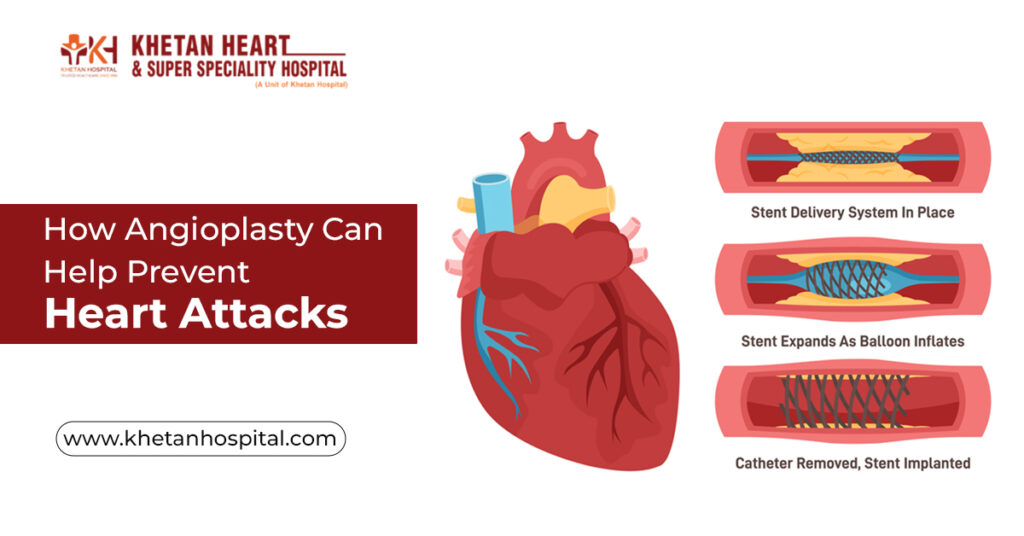Heart attacks don’t arrive with a polite warning. They sneak up on people, building slowly through years of clogged arteries until one day the heart says, “Enough.” The good news? Modern medicine has a clever way of stepping in before that collapse happens—angioplasty. Angioplasty for heart attack prevention is not just an emergency fix, but also a tool for prevention.
Why arteries matter more than we think
Our arteries are water pipes. When a mixture of cholesterol, fat, calcium, and plaque has built up, the passage narrows. When a blockage suddenly shuts down the supply, the heart can come under attack because blood flow is reduced, and the heart has to work harder.
That’s where angioplasty comes in: opening up the blocked pathway before it inflicts permanent damage.
Angioplasty in simple terms
Angioplasty is a minimally invasive procedure to open clogged arteries. A balloon-tipped catheter is snaked through a blood vessel, and when it reaches the blockage, the balloon goes up to clear out the artery. Normally, a stent (small wire mesh tube) is inserted to keep it open.
The big advantage of angioplasty for heart attack prevention is to avoid open-heart surgery while restoring smoother flow.
Angioplasty procedure steps
No one likes to think they might undergo a medical procedure, but there is empowerment in understanding what’s next. Here’s how the basic flow goes:
- Preparation – Patient is given a light anesthetic, and a catheter is placed through the wrist or groin.
- Locating the clog – Doctors use imaging to help guide the catheter until it reaches the narrowed artery.
- Blowing up the balloon – The balloon gets large and squishes plaque against your walls.
- Inserting the stent –The artery is held open in the long term by a stent.
- Recovery – The majority of people go home within a day or two with instructions for lifestyle care.
Angioplasty as Heart Blockage Treatment
Angioplasty is one of the most common methods of heart blockage treatment. It’s fast, simple, and minimizes the risk of a repeat cardiac incident. But there’s a catch: the stent is not a free pass to return to old habits. Doctors also remind patients that angioplasty is particularly effective when accompanied by a healthier lifestyle.
Clearing up myths
Let’s tackle a few.
- “Too risky.” Actually, success rates are very high worldwide.
- “Lifestyle changes alone will clear arteries.” They help prevent further damage, but can’t reverse a blockage already sitting there.
- “Only older people need it.” Sadly, heart disease is showing up in younger groups, too.
“Truth may feel inconvenient, but it keeps your heart alive. Myths don’t.”
Benefits That Extend Beyond the Surgery
- Relief from chest pain (angina).
- Improved stamina for daily activities.
- Reduced probability of having another heart attack.
- Improved circulation to the heart muscle.
- Less recovery time than with a bypass operation.
These are the cases that cardiologists will often recommend angioplasty at the right time.
Life After Angioplasty
When the procedure is over, the journey does not end there. Doctors usually advise:
- Healthy eating – Fewer fried items and more vegetables and whole grains.
- No smoking – Nicotine and blood vessels are never a good mix.
- Moderate-to-high intensity workout – Walking, yoga or cycling light does wonders.
- medication adherence – If you skip your prescribed medications, it defeats the purpose.
- Frequent visits – The best way to avoid big problems is to catch them early.
In other words, angioplasty restores that old plumbing, but the householder must keep up maintenance.
Every day habits make the difference
It doesn’t have to be drastic. Little swaps matter. Cooking at home instead of takeout. Taking stairs instead of elevators. Sleeping enough hours instead of binge-watching till 2 a.m. These don’t sound heroic, but together they reduce strain on the heart.
“An artery opened today can be closed again tomorrow—unless you change the routine that clogged it.”
Guidance that matters
Naturally, the issue is not simply one of process. The right expertise matters too. A trained Heart Specialist in Jaipur, for example, at Khetan Hospital knows how to tie an angioplasty, medication, and lifestyle change together into a plan that works for you. That advice forms not just survival but also quality of life over the long term
Wrapping it up
Angioplasty isn’t just an emergency tool. It’s a chance to give the heart a smoother road, to restore blood flow, and to prevent a tragedy before it happens. But it only works if paired with consistent care afterward. Think of it as a reset button—press it, then live differently.
Because at the end of the day, the heart doesn’t need perfection. It needs consistency.

